EUSCREEN MEETING 2021 | ZAANDAM | THE NETHERLANDS
On Monday and Tuesday, June 28-29th, the final meeting of the EUSCREEN Study will take place in Zaandam, Netherlands. Because of the ongoing COVID-19 situation, this will be a hybrid meeting. The meeting will be broadcast live here on the EUSCREEN website.
The scientific sessions will take place on both days from 8:30 AM to 3:30 PM (Central European Summer Time, UTC +2). All talks will be 10 to 15 minutes long, followed by 5 minutes of discussion. Talks of participants who are able to attend will be broadcast live and talks of participants who will not be able to attend the meeting in person will have been pre-recorded.
Anyone who is logged in to YouTube can participate in a live chat during the meeting. Logging in to YouTube requires a Google account (i.e. a gmail address). The live chat will be moderated and can also be used to ask questions for the live discussion.
PROGRAMME
20:00 Concert by Nóra Dúdas (famous organ built by Johannes Petrus Künckel in 1784), Anna Lachegyi (viola da gamba) and Eveline Heijnsdijk (recorder)
- J.P. Sweelinck: Ich ruf zu Dir, Herr Jesu Christ
- Sainte Colombe – Prelude and Chaconne in d
- A. Kühnel: Sonata for viola da gamba & continuo No.10, Aria
- G.Ph. Telemann F major Sonata TWV: 41 F2
- J.S. Bach Sonata in g minor BWV 1029
- J.S. Bach Toccata en fugue in d minor BWV 565
Web Congress: Live and web participants all register here in advance for the congress. Participation is free. Note that for calculating with the cost-effectiveness model you have to register here.
7:00 Breakfast in restaurant next to church with waterfront terrace
8:30 Opening of the congress by the Mayor of Zaanstad: Jan Hamming
Introduction about the wooden “Baptist Admonition” church built in 1687, by Marius Romeijn
Note: Before each session all remote speakers (indicated by “video”) are invited to join in the Zoom meeting. During the session anybody can pose a question by chat and then the moderator can invite this person by sending a link to the Zoom meeting. After the talk this person poses the question live in the Zoom meeting (preferably with camera on).
9:00 Session 1: Preparation of the EUSCREEN study
- First cost-effectiveness model studied effectiveness of vision screening before age 3 in the Netherlands (Frans-Willem Goudsmit, Herb Simonsz)
- Two consecutive birth cohorts (n=11,000) with and without screening before age 3 (Frea Sloot, Herb Simonsz)
EUSCREEN’s challenge in 2016: Diversity screening programmes makes it impossible to compare their cost-effectiveness
9:30 Session 2: Inventory of hearing screening programs in 40 countries in Europe and 6 countries beyond (moderators: Inger Uhlén, Herb Simonsz)
- Neonatal hearing screening I (Andrea Bussé, André Goedegebure)
- Neonatal hearing screening II (Alison Mackey, Inger Uhlén)
- Childhood hearing screening (Allison Mackey, Inger Uhlén) (video)
- Inventory of vision screening programs in all countries in Europe and 6 countries beyond: Childhood vision screening (Jill Carlton, Mandy Nordmann) (video)
10:30 Coffee in restaurant next to church with waterfront terrace
11:00 Session 3: Implementation of hearing screening in three provinces of Albania (moderators: Martijn Toll, Herb Simonsz)
- From the screeners’ perspective (Birkena Qirjazi, Ervin Toci) (video)
- From the perspective of implementation study (Andrea Bussé, Martijn Toll)
Implementation of vision screening in Cluj County in Romania
- From the screeners’ perspective (Mihai Mara, Daniela Rajka, Alin Vladescu) (video)
- Procedure for measuring visual acuity at vision screening (Maria Fronius) (video)
- From the perspective of implementation study (Jan Kik, Mandy Nordmann)
12:30 Lunch in restaurant next to church with waterfront terrace
13:30 Session 4: Photoscreening and autorefraction used for screening (moderators: Parinaz Rostamzad, Herb Simonsz)
- Vision and hearing screening programmes in Flanders (Bart van Overmeire, Maaike Deschoemaeker)
- Population-wide photoscreening in Flanders (Parinaz Rostamzad)
- How can we improve vision screening in countries with optometrists like Latvia (Zanda Ruskule) (video)
- Review and cost-effectiveness of photoscreening and auto-refraction (Anna Horwood) (video)
- Early Glasses Study: RCT on effect of glasses at age 1 (refraction>AAPOS 2003) on development of amblyopia at age 4 (Annelies Bruinenberg)
15:30 Departure for climbing windmills at the Zaanse Schans (choose between mustard seed, timber or paint mills)
18:30 Congress dinner at Restaurant “Hope for the Black Whale” at the Zaanse Schans (please mail fish or meat preference)
7:00 Breakfast in restaurant next to church with waterfront terrace
8:30 Session 5: Amblyopia free papers (moderators: Jan-Roelof Polling, Sjoukje Loudon)
- Randomized controlled trial comparing dichoptic games with occlusion therapy for amblyopia (Aveen Kadhum, Sjoukje Loudon)
- Ophthalmological findings in a large pediatric population, the Generation R Study (Jan-Roelof Polling)
- A new binocular therapy for refractory amblyopia (Dongsheng Yang, Ping Wang, Ya Pan, Jie Zhang, Deshun Li, Lin Wang, Di Zhang) (video)
9:15 Session 6: Implementation of vision and hearing screening programmes (moderators: Inger Uhlén, Sjoukje Loudon)
- Implementation of a universal newborn hearing screening program, the Portuguese experience (Luisa Monteiro)
- Israel is contemplating nation-wide photoscreening (Lisa Rubin)
- Vision screening in Hungary (Csilla Serfőző, Anna Soproni)
- Obstacles to childhood vision screening in Ruanda (Lieke Gouma, Piet Noe)
- National vision screening in India aims at refractive errors at age 9-14: How much
amblyopia would be detected by screening at an earlier age (Zia Chaudhuri, Eveline Heijnsdijk) (video)
10:30 Coffee in restaurant next to church with waterfront terrace
11:00 Session 7: Conditions for and cost-effectiveness of vision and hearing screening (moderators: Harry de Koning, Jan Kik)
- EUSCREEN cost-effectiveness model for childhood vision and hearing screening (Eveline Heijnsdijk)
- Costs of vision screening and costs of treatment of amblyopia (Anna Horwood) (video)
- Current monitoring in paediatric vision and hearing screening in Europe & what more would be needed for comparative, cross-border, cost-effectiveness analysis (Jan Kik)
- Acceptability of childhood screening (Jill Carlton) (video)
Round Table: EUSCREEN manual for implementation or modification of childhood vision and hearing screening programmes (all co-authors of the Manual, led by Jan Kik; the Manual will be made public on the EUSCREEN website on June 25th)
12:30 Lunch in restaurant next to church with waterfront terrace
13:30 Session 8: Cost-Effectiveness JAM SESSION of EUSCREEN Model predictions
The EUSCREEN Country Representatives who worked so hard for the EUSCREEN Study by filling out the extensive questionnaire for the inventory of screening programs will conclude their contribution to the EUSCREEN Study by calculating the cost-effectiveness of the vision or hearing screening programme in their country. All or, if many, a selection of calculations will be discussed in an open, plenary discussion, aimed at generating new ideas.
The Country Representatives will join the ZOOM meeting directly (preferably with camera). Others can join (preferably with camera) after first posing a question by chat. We hope that Harry de Koning, professor of Public Health, will be able to moderate this JAM SESSION (he is extremely busy), to be assisted by Inger Uhlén for hearing screening issues and by Herb Simonsz for vision screening issues.
16:00 Meeting ends
Session 1
Session 2
Session 3
Session 4
Session 5
Session 6
Session 7
Session 8
LIVE REGISTRATION JUNE 28th 2021
LIVE REGISTRATION JUNE 29th 2021
LIVE CONCERT JUNE 27th 2021
Concert by Nóra Dúdas (famous organ built by Johannes Petrus Künckel in 1784), Anna Lachegyi (viola da gamba) and Eveline Heijnsdijk (recorder)
(This concert was not funded by the EU, but by an anonymous sponsor)
Because the audio in the video is compressed and therefore of low quality, the six pieces are also available below as audio-only in high quality.
Jan Pieterszoon Sweelinck (1562-1621):
Ich ruf zu dir (variation) SwWV305
Sweelinck was a Dutch organist and composer. He played for several years in the Old Church of Amsterdam. His variation on the protestant hymn Ich ruf zu dir, Herr Jesu Christ is one of his keyboard composition in which a liturgical melody was used as basic idea. It is interesting to know about Sweelinck’s variations that the different variations are in most of the cases mirroring the text of the original choral, psalm or hymn verse by verse. This is also the case in the Ich ruf zu dir Herr Jesu Christ. However, there are different ways in how Sweelinck applies the adaptation of the text. In the variation upon Ich ruf zu dir hymn seems to mirror the text from the second verse on, so the four variations represent verses 2, 3, 4 and 5 of the original hymn, according to Julia Dokter.
Monsieur de Sainte-Colombe (ca. 1640-1700):
Prelude and Chaconne in d minor
Sainte-Colombe was a celebrated French master of the viola da gamba, and an important teacher – his students include the most prominent viol payers of that time. He is credited with adding an extra seventh string on the bass viol. A lot of his music was lost, but we have two books of his solo viol pieces, and a collection of 67 pieces for two bass viols.
August Kühnel (1645-1700):
Aria X
Kühnel was a German composer and accomplished viola da gamba performer. One his his best known pieces from the collection Sonate o Partite is undoubtedly Aria no. 10: a solo sonata, designated Aria, with nine variations on the chorale Herr Jesu Christ, du höchstes Gut.
G.Ph. Telemann (1681-1767):
F major Sonata TWV: 41 F2
The German composer Telemann was the first composer who produced musical pieces in series in the lessons he published every two weeks in his musical periodical Der getreue Musikmeister (The faithful Music Master). Today, 25 of such leaflets are available. This sonata TWV 41:F2 for recorder and basso continuo was based on a copy preserved in the Municipal Library in Leipzig.
Johann Sebastian Bach (1685-1750):
Sonata in g minor
The famous German composer wrote three sonatas for viola da gamba and obbligato harpsichord around 1720, when the viola da gamba was already an archaic instrument, superseded by string bass variants such as the cello and double-bass. The three sonatas are a very important part of the concert repertoire today, performed on the cello, viola or viola da gamba. The musicologist Philipp Spitta has described this g minor sonata as being “of the greatest beauty and most striking originality.”
Johann Sebastian Bach (1685-1750):
Toccata and Fugue in d BWV565
Beside the popularity of the Toccata and Fugue BWV565 by Johann Sebastian Bach, it is important to mention that there is no original manuscript has been found of the d minor toccata and fugue for the organ but a perfectly made copy. Several researches suggest that the original music, which inspired this organ piece was composed to lute. It has been concluded by analysing the virtuoso structure and passages which correspond to lute compositions of Bach (especially with BWV1004) and which are in contrast to the complexity of the other toccata and fugue by Bach.
ZAANSE SCHANS LIVE
Zaanse Schans is a neighbourhood of Zaandam, near Zaandijk, Netherlands. It is best known for its collection of well-preserved historic windmills and houses.
It derived its name from the river Zaan and its original function as sconce (schans in Dutch) against the Spanish troops during the Eighty Years’ War of Dutch independence.
There are 8 windmills, which were built after 1574.
De Huisman (The Houseman), a mustardmill |De Gekroonde Poelenburg (The Crowned Poelenburg), a sawmill | De Kat (The Cat), a dyemill | Het Jonge Schaap (The Young Sheep), a sawmill | De Os (The Ox), an oilmill | De Zoeker (The Seeker), an oilmill | Het Klaverblad (The Cloverleaf), a sawmill |De Bonte Hen (The Spotted Hen), an oilmill.
VERRASSING AAN DE ZAAN
 Verrassing aan de Zaan translates to Surprise at the Zaan. It’s a brand new restaurant situated next to the old chuch and the river Zaan.
Verrassing aan de Zaan translates to Surprise at the Zaan. It’s a brand new restaurant situated next to the old chuch and the river Zaan.
Breakfast, lunch and coffeebreaks will be served here during the congres.
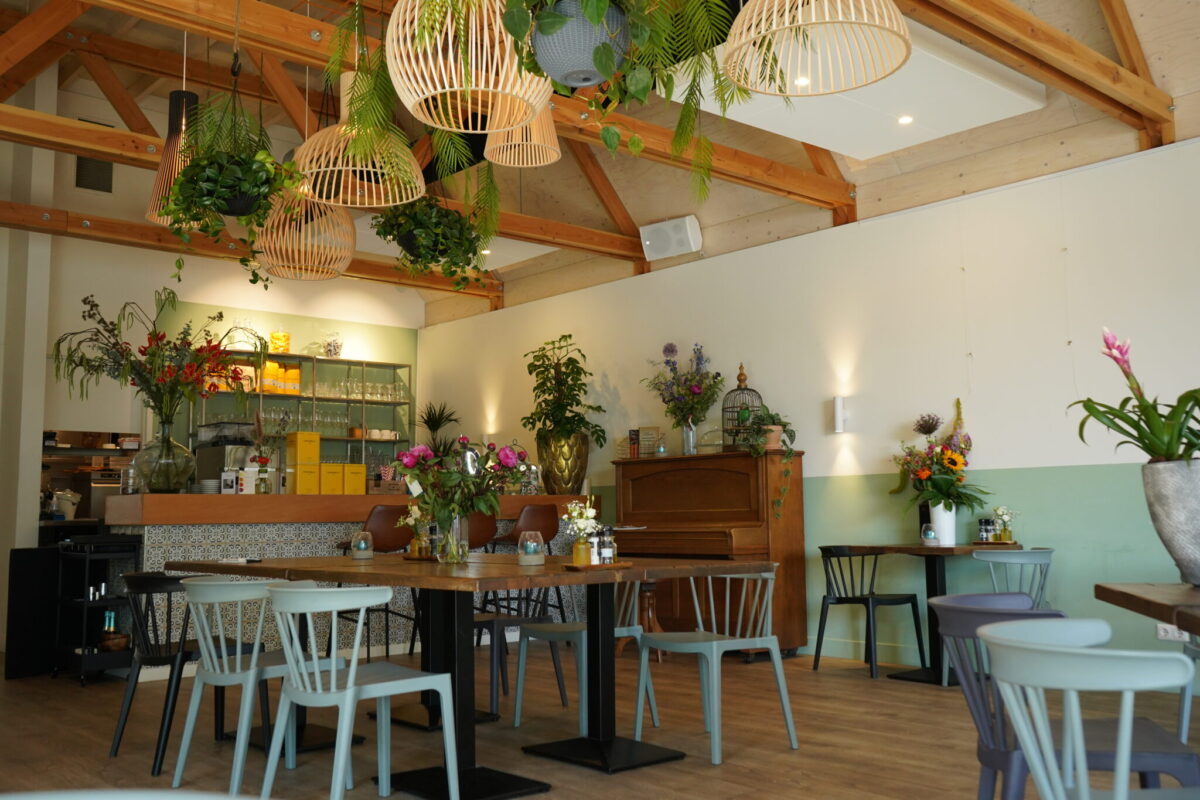
Restaurant De Hoop op d’Swarte Walvis
On August 8th 1965, the “Zaanse Molen” association existed for 40 years already. On that celebratory day, the first meal ever was enjoyed at what later would become restaurant D’Swarte Walvis. Mrs Bosman, one of the founders of the Zaanse mustard and one of the first people to live on the Zaanse Schans, organised this dinner with sandwiches from bakery Doba and soup provided by Honig. This is where the story of this beautiful restaurant begins…
Anabaptists and the ‘Admonition Building’ in Zaandam
Marius Romijn, pharmacist, June 28th, 2021
Mennonites were present in the Netherlands since 1530, almost five centuries ago.
Main characteristics were at the time:
- Biblical believer’s baptism
- ‘Congregation without spot or wrinkle’ as guarantee for salvation of one’s soul
- Often defenceless
- ‘Yes is yes and no is no’: no oath
One can wonder why baptism spread so rapidly in this area. My theory is that Wessel Gansfort (1420-1489), a biblical humanist, developed a symbolical concept of the Catholic Mass, and renounced transsubstantiation (the teaching of the Catholic Church: “the change of bread into the Body of Christ and of wine into the Blood of Christ). This became rather popular and was called ‘Sacramentism’. Through C.H. Hoen this convinced Zwingli in Switzerland and through him the Swiss and again the Dutch anabaptists. This part of Anabaptism was acceptable for Sacramentists, who did not, however, reject baptism of infants.
The Anabaptists spread from Zürich, 1525, first to countries in Europe, eventually to other continents! Now about two million people are anabaptists.
In the Netherlands, some groups of Anabaptists were relatively liberal in the beginning, and Anabaptists became liberal in general from the 19th century onwards.
In the Netherlands every local anabaptist community is autonomous. Anabaptists in the Netherlands are not a ‘church’.
The Münster rebellion was an attempt by radical Anabaptists to establish ‘the Kingdom of God’ in the German city of Münster. Melchior Hoffman initiated adult baptism in Strasbourg in 1530 and helped lay the foundations for the events of 1534–35 in Münster. The city was under Anabaptist rule from February 1534 until its fall in June 1535 when the city was retaken by its expelled bishop. Some nonresistant Anabaptists found leaders in Menno Simons and the brothers Obbe and Dirk Philips, Dutch Anabaptist leaders who repudiated the distinctive doctrines of the Münster Anabaptists. This group eventually became known as the Mennonites after Simons. They rejected any use of violence and preached a faith based on compassion and love of enemy.
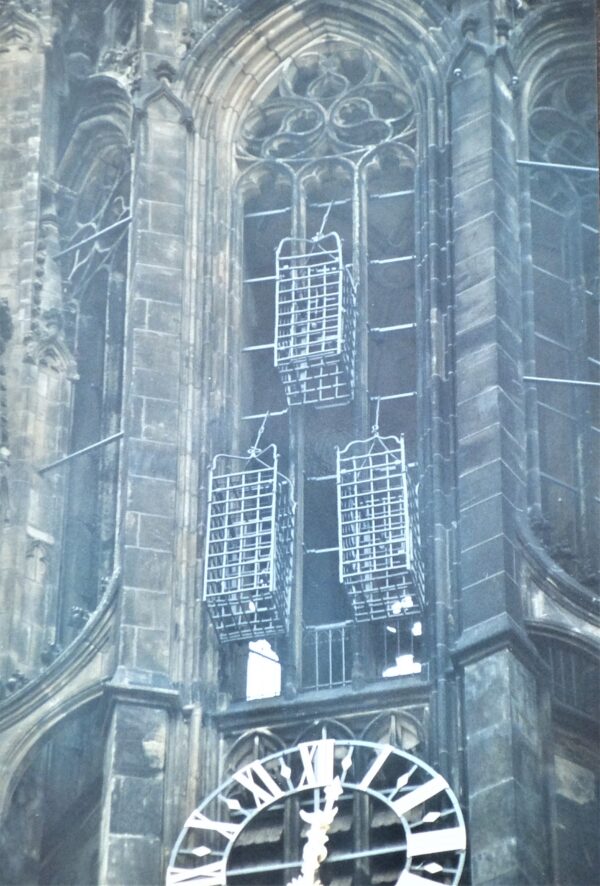
Münster Church tower
Three cages for the bodies of prominent anabaptist leaders.
Failed attempt at God’s kingdom in Münster 1534-1535. This ended in bloodshed.
Especially afterwards heavy persecution, more than thousand martyrs in the Netherlands.
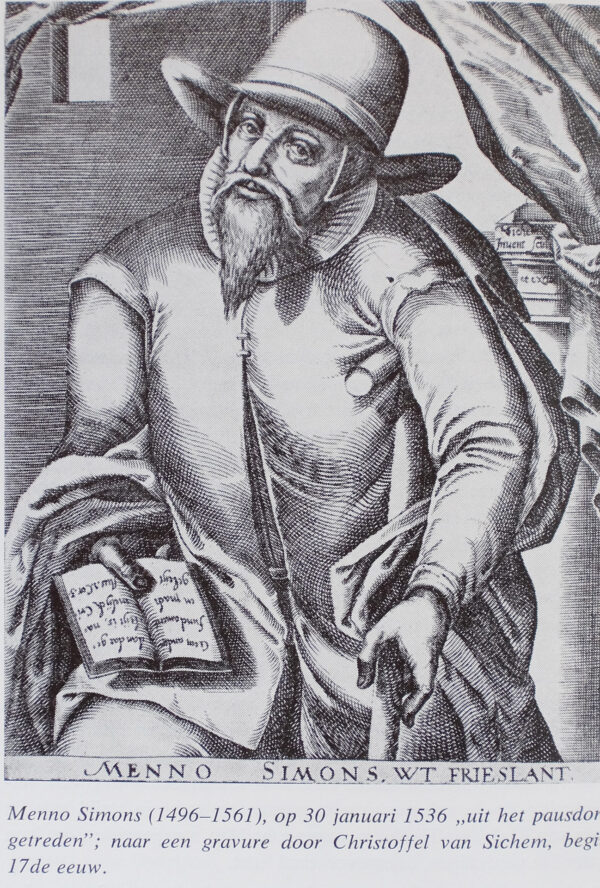
Menno Simons (1496-1561)
In 1536 Menno Simons, until then a catholic pastor at Witmarsum in Friesland joined them. He is not the founder or the only leader, which idea may have arisen because he published much. In other countries Anabaptists are called: ‘Mennonites’ , but in the Netherlands: Anabaptists (in Dutch: ‘Doopsgezinden’).
Calvinism emerged from the beginning of the revolt against Spanish rule, around 1560. It became the strongest Protestant religion, perhaps due to more rigid organization.
Anabaptists in the Netherlands were soon divided, mainly about the ‘Way of life’, less about doctrine. After the Act of Abjuration (Dutch: ‘Plakkaat van Verlatinghe’, the declaration of independence by the Netherlands from Spain) they were tolerated instead of persecuted, from 1672 onwards they were recognized, from 1795 onwards they had equal rights.
Zaandam consisted, until the reorganization of communes by Napoleon in 1811, of two villages, East and West Zaandam, which had during most of the 17th century six Mennonite denominations. Their differences concerned orthodoxy and liturgical aspects such as foot washing.
In 1687 the ‘Flemish’ and the ‘Waterland’ denominations, both liberal, merged: They built a new, larger ‘Admonition’ building.
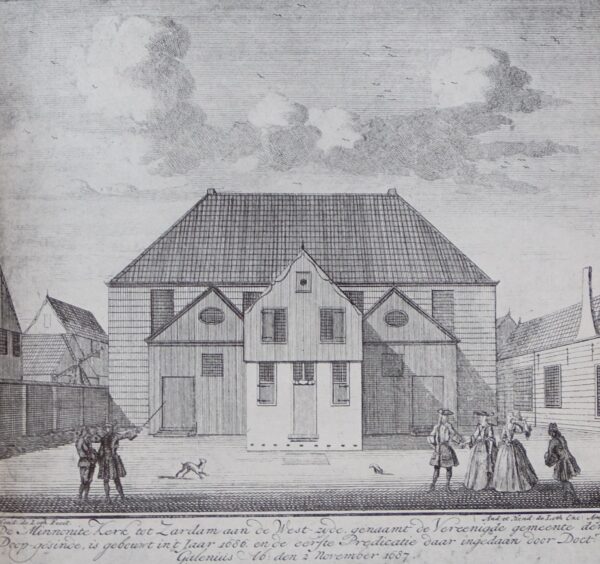
The “New House’, as it was called, in the 17th century.
It was built in four months and it was designed by shipwrights.
The roof was built as an inverted widened sea ship. It was a ’Wooden building’, but still contained 100.000 bricks between the posts.
The building had no organ in those days in line with the Anabaptists’ strive for simplicity. The singing was led by cantors.
The Admoniton building has sand on the floor – Many people ask why? However, in the 17th century, sand on the floor was standard in a house, farm, inn or smaller church. Because of the sand and the wooden building, the acoustics for chamber music are at least equal to the Recital Hall of the Concertgebouw in Amsterdam.
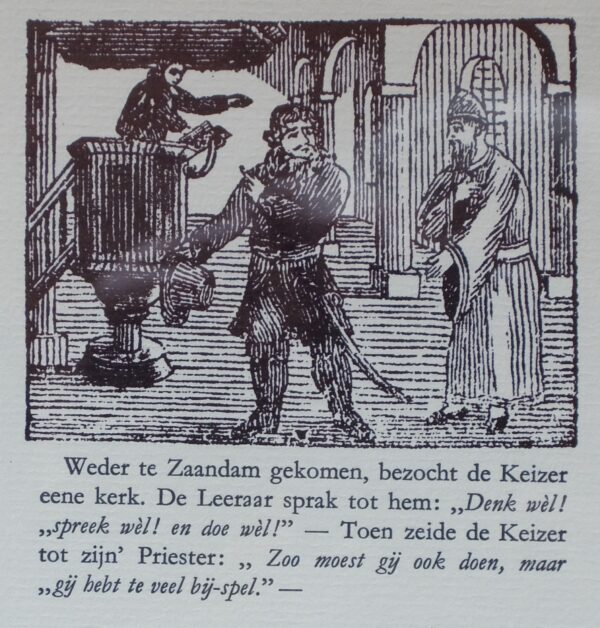
Part of the ‘cent-print’ (19th Century, about Tsar Peter in Zaandam)
After a short first visit to Zaandam in 1697, Tsar Peter the Great stayed longer in 1717. Zaandam was most advanced in ship building in these days and Tsar Peter the Great needed a large navy to establish harbours both in the Black Sea and in the Baltic sea.
In Zaandam he stayed with Cornelis Kalf, a merchant and charity preacher living at Westzijde 38 in Zaandam, the house still exists.
The Tsar spoke and understood Dutch. Cornelis Kalf had to deliver a sermon. the Tsar wanted to keep it short, so Cornelis Kalf only read the last part of the sermon: ‘Think well, speak well, do well, in the fear of the Lord Amen.’
The Tsar was enthusiastic and later said to the Pope: ‘That is how you should preach too, you have too much by-play!’
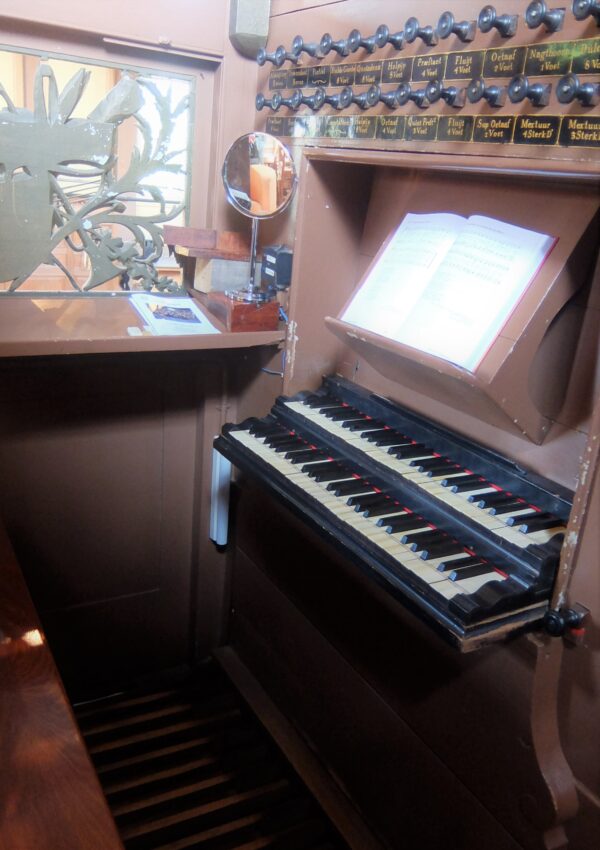
Console organ by Künckel
In 1784 the present organ of the Admonition building was built by Johannes Petrus Künckel, a Rotterdam organ builder of German descent. It was the first organ with the console on the side which guaranteed more contact between the player and the people in the church. On the other side there is also an extension of the organ, according to the symmetrical Louis XVI style, but it is empty and contains no console.
Twenty organ voices is relatively luxurious However, the organ pedal is only a connection to the keyboards; the instrument was not designed for concerts, but for vocal accompaniment.
In 1840 Rev. Leenderts of this congregation broke his hip bone. Rev. Van Geuns of the Frisian congregation, took over for six months, also as pastor at the services, (their ‘Admonition’ was quite near). A dialogue resulted, the differences turned out to be small so that the two communities merged.
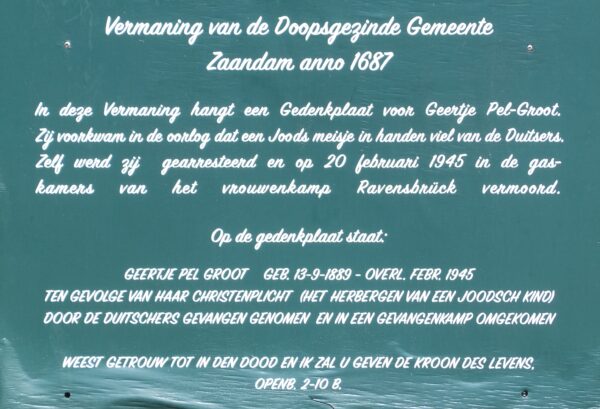
Plaque outside about Geertje Pel-Groot
1940-45: During the Second World War, a housewife, Geertje Pel, hid a Jewish child. She was betrayed in 1944 and murdered in the concentration camp Ravensbrück. The girl, however, could be sent into hiding in time and survived.
In 1948 the last merger of the anabaptist communities at East and West Zaandam occurred.
After 2000 more cooperation with other Mennonite communities in the Zaan area evolves. Services alternated in different Admonitions.
Note on the author: Marius Romijn worked as a pharmacist in Zaandam and, after retirement, obtained a M.A. degree in Science of Religion, route Bibles and Cultures at the University of Amsterdam in 2006.
